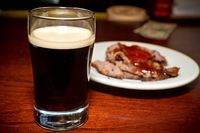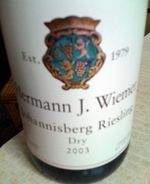Here is a sampling of what our editors and contributors were drinking last week…
 Lenn Thompson: Jacques Puffeney 2005 Savagnin Arbois
Lenn Thompson: Jacques Puffeney 2005 Savagnin Arbois
"Most of our customers don't like this."
That's what our waiter at Bar Boulud said as he poured me a sip after I ordered a glass this Jura white. We had already established that we were wine lovers, so he meant it more as a badge of honor for me than any sort of warning.
He clearly didn't need to warn me — it was a revelation.
Clearly oxidized with a streak of acetone that took me back to organic chemistry lab in college, there were layers of salted nuts and lemon zest and a burst of acidity and subtle walnut skin tannins on palate that is reminiscent of Fino Sherry.
And this was only one of the incredibly interesting wines we had that night. I also tasted my first Jura red (Stefphane Tissot 2009 Poulsard), my first Austrian dessert wine (a chardonnay that I forgot to take a picture of) and a glass of La Crau de Ma Mere 2006 Chateauneuf du Pape from Jeraboam — part of the restaurants well-known big bottle by the glass program.
It's clear that Michael Madrigale, chief sommelier, is targeting wine geeks. I mean, who has three Jura wines available by the glass? That's insane. And I thank him for his insanity.
Evan Dawson: Hermann J. Wiemer Vineyard 2003 Johannisberg Riesling
In a very basic sense, wine can be grouped into three categories. The first includes wines that should be drunk now, young, before they inevitably fade. The second includes wines that can be enjoyed at a young age but have the structure to hold their character with grace for a reasonable period of time.
That brings us to the third and very rare category of wines that actually improve with age. Sometimes they're unapproachable when young (traditional Nebbiolo, for example) and sometimes they're enjoyable soon after bottling. But a little time in the bottle brings even more interesting character, more complexity.
This is a very subjective category, of course. But I'll go ahead and include this wine, the Wiemer '03 Dry, which was positively enthralling when we drank it this past weekend. Why is it better with age? Try to imagine a Riesling that maintains its same youthful freshness — almost no hint of even the early stages of oxidation — while adding weight and texture in the mouth. Lively but rich, but not heavy. This is starting to sound like one giant contradiction, which is what many great wines seem to be.
We have one more bottle. It seems almost perfect now. We're eager to try it again. But when?
 David Flaherty; Heartland Brewery, Kelly's Quad Bock
David Flaherty; Heartland Brewery, Kelly's Quad Bock
Most places give you a watch when you reach your 10th anniversary with a company (or if you're lucky, a lucite paperweight with your name on it and a cheap pen sticking out the top). In Brewmaster Kelly Taylor's case, they let him brew a beer. And they let him go big. And I mean big.
Normally known for lower alcohol, session beers that cover a wide-range of styles, Kelly — who also brews for his own label, Kelso, and contract brews for clients — went for something special. A "quad bock" — yeah, I know, it doesn't exist.
Until now. 10 malts, 10 hops and 10% alcohol.
I was fortunate to have it straight out of the tap last night at the brewery with the man, himself.
Roasted caramel notes with a dark fruit core and a velvety mouthfeel. It was complex and smooth, layered in depth and flavor; a perfect way to encapsulate ten years of hard work in front of the steaming brew kettle.
I'll take one of these over a damn paperweight, any day. Congrats, sir.
(Photo credit: Chris Lehault of IDrunkThat.com)

